Taxation of Timber Sales in Australia
VerifiedAdded on 2020/03/07
|14
|2933
|162
AI Summary
This assignment examines the taxation implications of selling felled timber in Australia. It delves into specific sections of the Income Tax Assessment Act, particularly section 26(f), and utilizes the case McCauley v. The Federal Commissioner of Taxation (1944) to illustrate how revenue from timber sales is treated as taxable income. The analysis concludes that disposing of felled timber constitutes assessable income for taxpayers and subject to tax upon receiving payment from the sale.
Contribute Materials
Your contribution can guide someone’s learning journey. Share your
documents today.

Running head: TAXATION LAW
Taxation
Name of the Student
Name of the University
Authors Note
Course ID
Taxation
Name of the Student
Name of the University
Authors Note
Course ID
Secure Best Marks with AI Grader
Need help grading? Try our AI Grader for instant feedback on your assignments.
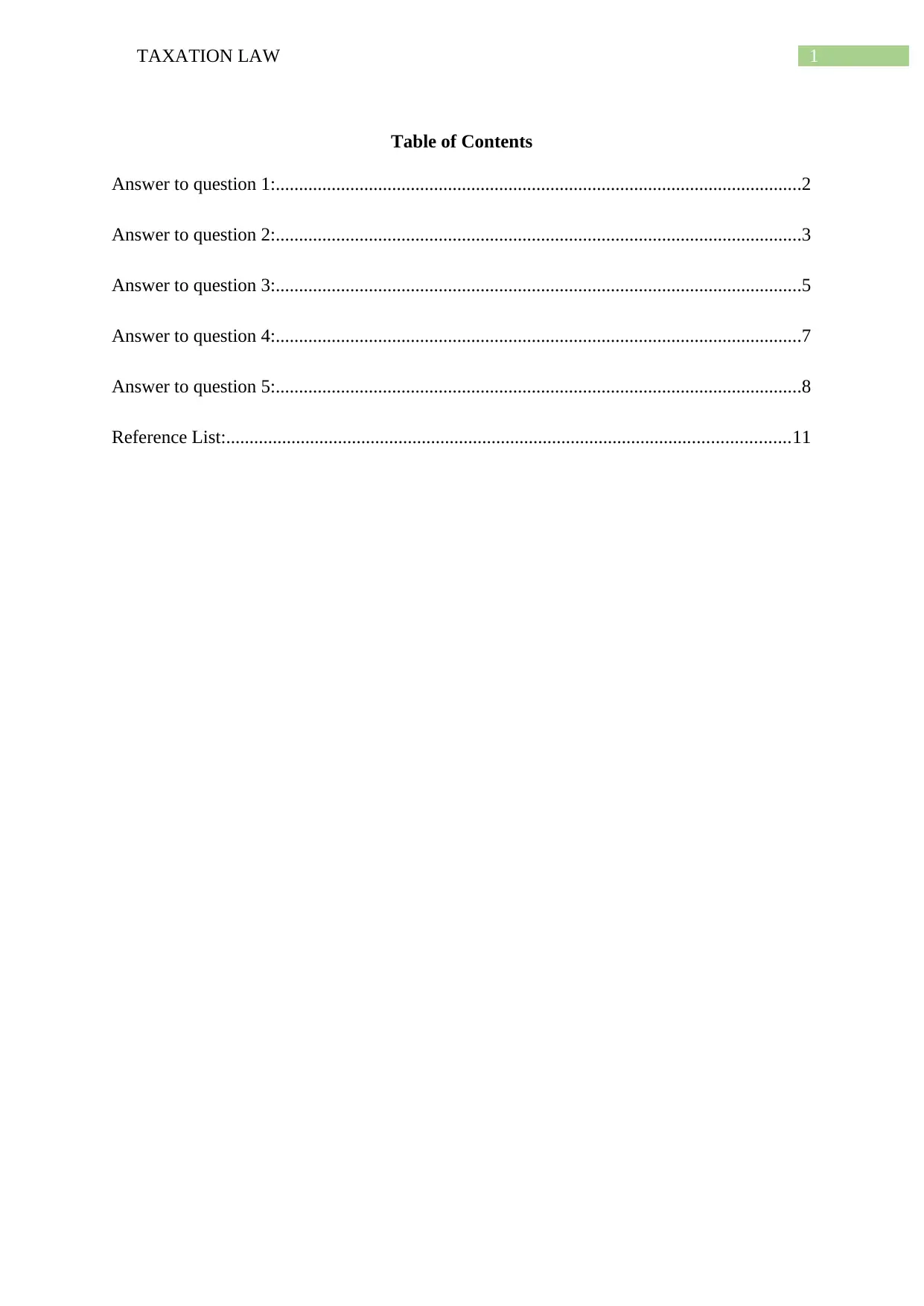
1TAXATION LAW
Table of Contents
Answer to question 1:.................................................................................................................2
Answer to question 2:.................................................................................................................3
Answer to question 3:.................................................................................................................5
Answer to question 4:.................................................................................................................7
Answer to question 5:.................................................................................................................8
Reference List:.........................................................................................................................11
Table of Contents
Answer to question 1:.................................................................................................................2
Answer to question 2:.................................................................................................................3
Answer to question 3:.................................................................................................................5
Answer to question 4:.................................................................................................................7
Answer to question 5:.................................................................................................................8
Reference List:.........................................................................................................................11

2TAXATION LAW
Answer to question 1:
Issues:
The present issues is concerned with the determination of net capital gains or losses
derived by the taxpayer under the ITAA 1997.
Legislation:
a. Section 108-20 of the Income Tax Assessment Act 1997
b. Section 108-10 of the Income Tax Assessment Act 1997
Computation of net capital loss for the year
Particulars Amount ($)
Loss on sale of Antique Chair $2,000
Loss on sale of Painting $8,000
Less: Gain on sale of Antique Vase $1,000
Total Collectable loss to be carried forward $9,000
Asset Description
Cost
Base
Capital
Proceeds
Capital
gains
Capital
loss
Antique Vase $2,000 $3,000 $1,000
Antique Chair $3,000 $1,000 $2,000
Painting $9,000 $1,000 $8,000
Home Sound System $12,000 $11,000 $1,000
Shares in listed company $5,000 $20,000 $15,000
Computation of Net capital gains for the year
Particulars Amount ($)
Gains on sale of shares $15,000
Applications:
a. As defined under section 108-20 of the Income Tax Assessment Act 1997, no loss
can be allowed for offset from the disposal of assets that are for personal use. Eric
Answer to question 1:
Issues:
The present issues is concerned with the determination of net capital gains or losses
derived by the taxpayer under the ITAA 1997.
Legislation:
a. Section 108-20 of the Income Tax Assessment Act 1997
b. Section 108-10 of the Income Tax Assessment Act 1997
Computation of net capital loss for the year
Particulars Amount ($)
Loss on sale of Antique Chair $2,000
Loss on sale of Painting $8,000
Less: Gain on sale of Antique Vase $1,000
Total Collectable loss to be carried forward $9,000
Asset Description
Cost
Base
Capital
Proceeds
Capital
gains
Capital
loss
Antique Vase $2,000 $3,000 $1,000
Antique Chair $3,000 $1,000 $2,000
Painting $9,000 $1,000 $8,000
Home Sound System $12,000 $11,000 $1,000
Shares in listed company $5,000 $20,000 $15,000
Computation of Net capital gains for the year
Particulars Amount ($)
Gains on sale of shares $15,000
Applications:
a. As defined under section 108-20 of the Income Tax Assessment Act 1997, no loss
can be allowed for offset from the disposal of assets that are for personal use. Eric
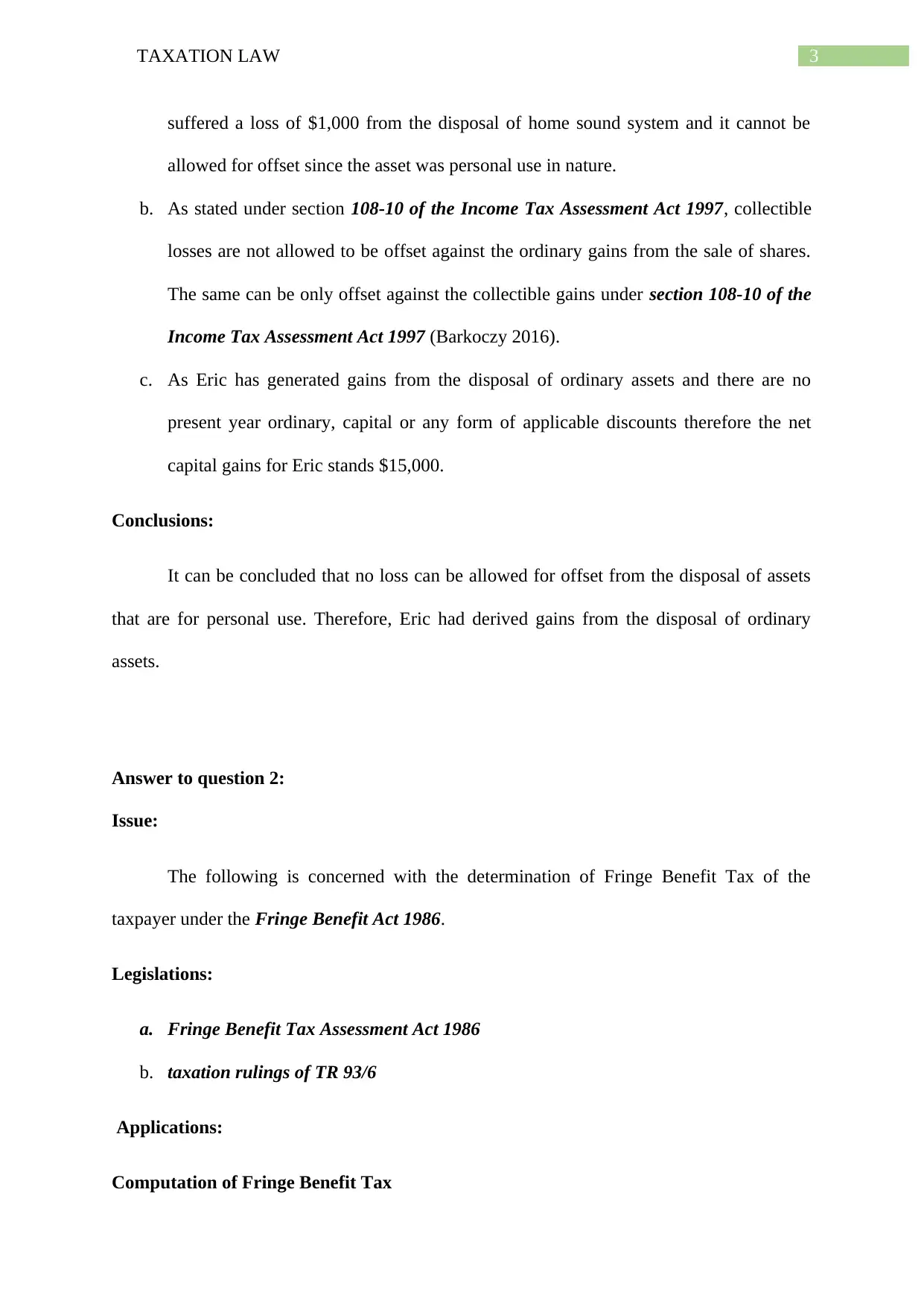
3TAXATION LAW
suffered a loss of $1,000 from the disposal of home sound system and it cannot be
allowed for offset since the asset was personal use in nature.
b. As stated under section 108-10 of the Income Tax Assessment Act 1997, collectible
losses are not allowed to be offset against the ordinary gains from the sale of shares.
The same can be only offset against the collectible gains under section 108-10 of the
Income Tax Assessment Act 1997 (Barkoczy 2016).
c. As Eric has generated gains from the disposal of ordinary assets and there are no
present year ordinary, capital or any form of applicable discounts therefore the net
capital gains for Eric stands $15,000.
Conclusions:
It can be concluded that no loss can be allowed for offset from the disposal of assets
that are for personal use. Therefore, Eric had derived gains from the disposal of ordinary
assets.
Answer to question 2:
Issue:
The following is concerned with the determination of Fringe Benefit Tax of the
taxpayer under the Fringe Benefit Act 1986.
Legislations:
a. Fringe Benefit Tax Assessment Act 1986
b. taxation rulings of TR 93/6
Applications:
Computation of Fringe Benefit Tax
suffered a loss of $1,000 from the disposal of home sound system and it cannot be
allowed for offset since the asset was personal use in nature.
b. As stated under section 108-10 of the Income Tax Assessment Act 1997, collectible
losses are not allowed to be offset against the ordinary gains from the sale of shares.
The same can be only offset against the collectible gains under section 108-10 of the
Income Tax Assessment Act 1997 (Barkoczy 2016).
c. As Eric has generated gains from the disposal of ordinary assets and there are no
present year ordinary, capital or any form of applicable discounts therefore the net
capital gains for Eric stands $15,000.
Conclusions:
It can be concluded that no loss can be allowed for offset from the disposal of assets
that are for personal use. Therefore, Eric had derived gains from the disposal of ordinary
assets.
Answer to question 2:
Issue:
The following is concerned with the determination of Fringe Benefit Tax of the
taxpayer under the Fringe Benefit Act 1986.
Legislations:
a. Fringe Benefit Tax Assessment Act 1986
b. taxation rulings of TR 93/6
Applications:
Computation of Fringe Benefit Tax
Secure Best Marks with AI Grader
Need help grading? Try our AI Grader for instant feedback on your assignments.
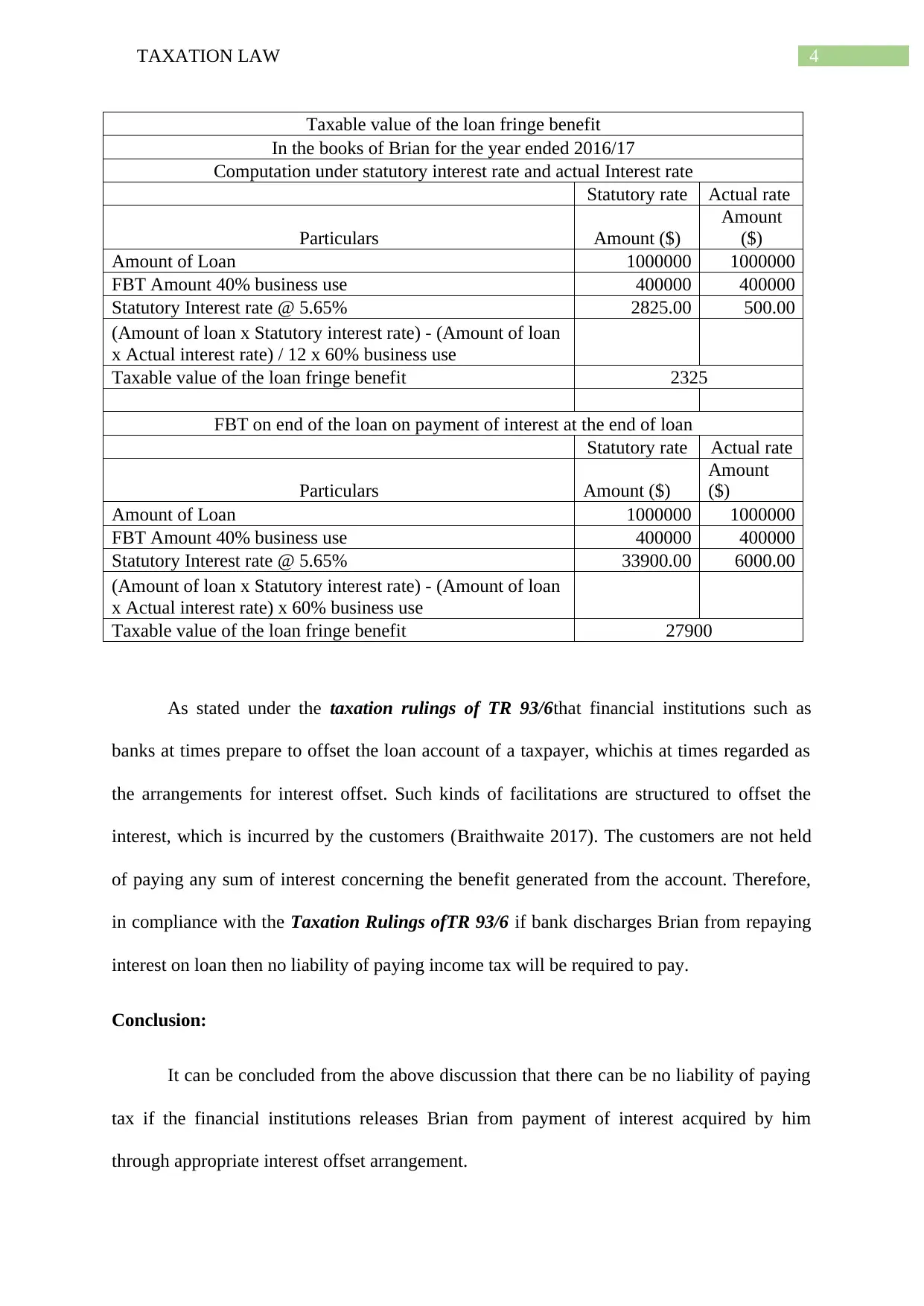
4TAXATION LAW
Taxable value of the loan fringe benefit
In the books of Brian for the year ended 2016/17
Computation under statutory interest rate and actual Interest rate
Statutory rate Actual rate
Particulars Amount ($)
Amount
($)
Amount of Loan 1000000 1000000
FBT Amount 40% business use 400000 400000
Statutory Interest rate @ 5.65% 2825.00 500.00
(Amount of loan x Statutory interest rate) - (Amount of loan
x Actual interest rate) / 12 x 60% business use
Taxable value of the loan fringe benefit 2325
FBT on end of the loan on payment of interest at the end of loan
Statutory rate Actual rate
Particulars Amount ($)
Amount
($)
Amount of Loan 1000000 1000000
FBT Amount 40% business use 400000 400000
Statutory Interest rate @ 5.65% 33900.00 6000.00
(Amount of loan x Statutory interest rate) - (Amount of loan
x Actual interest rate) x 60% business use
Taxable value of the loan fringe benefit 27900
As stated under the taxation rulings of TR 93/6that financial institutions such as
banks at times prepare to offset the loan account of a taxpayer, whichis at times regarded as
the arrangements for interest offset. Such kinds of facilitations are structured to offset the
interest, which is incurred by the customers (Braithwaite 2017). The customers are not held
of paying any sum of interest concerning the benefit generated from the account. Therefore,
in compliance with the Taxation Rulings ofTR 93/6 if bank discharges Brian from repaying
interest on loan then no liability of paying income tax will be required to pay.
Conclusion:
It can be concluded from the above discussion that there can be no liability of paying
tax if the financial institutions releases Brian from payment of interest acquired by him
through appropriate interest offset arrangement.
Taxable value of the loan fringe benefit
In the books of Brian for the year ended 2016/17
Computation under statutory interest rate and actual Interest rate
Statutory rate Actual rate
Particulars Amount ($)
Amount
($)
Amount of Loan 1000000 1000000
FBT Amount 40% business use 400000 400000
Statutory Interest rate @ 5.65% 2825.00 500.00
(Amount of loan x Statutory interest rate) - (Amount of loan
x Actual interest rate) / 12 x 60% business use
Taxable value of the loan fringe benefit 2325
FBT on end of the loan on payment of interest at the end of loan
Statutory rate Actual rate
Particulars Amount ($)
Amount
($)
Amount of Loan 1000000 1000000
FBT Amount 40% business use 400000 400000
Statutory Interest rate @ 5.65% 33900.00 6000.00
(Amount of loan x Statutory interest rate) - (Amount of loan
x Actual interest rate) x 60% business use
Taxable value of the loan fringe benefit 27900
As stated under the taxation rulings of TR 93/6that financial institutions such as
banks at times prepare to offset the loan account of a taxpayer, whichis at times regarded as
the arrangements for interest offset. Such kinds of facilitations are structured to offset the
interest, which is incurred by the customers (Braithwaite 2017). The customers are not held
of paying any sum of interest concerning the benefit generated from the account. Therefore,
in compliance with the Taxation Rulings ofTR 93/6 if bank discharges Brian from repaying
interest on loan then no liability of paying income tax will be required to pay.
Conclusion:
It can be concluded from the above discussion that there can be no liability of paying
tax if the financial institutions releases Brian from payment of interest acquired by him
through appropriate interest offset arrangement.
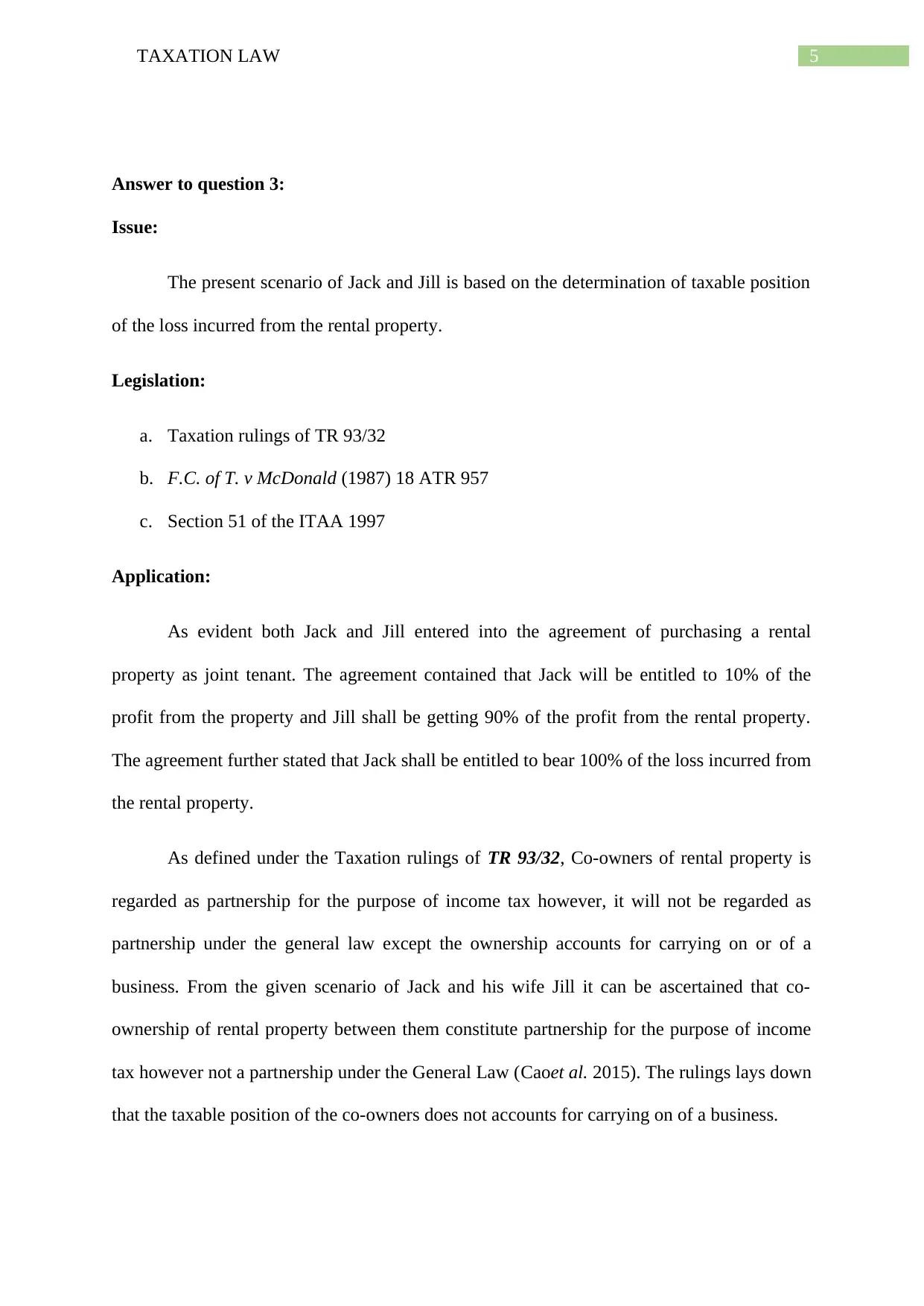
5TAXATION LAW
Answer to question 3:
Issue:
The present scenario of Jack and Jill is based on the determination of taxable position
of the loss incurred from the rental property.
Legislation:
a. Taxation rulings of TR 93/32
b. F.C. of T. v McDonald (1987) 18 ATR 957
c. Section 51 of the ITAA 1997
Application:
As evident both Jack and Jill entered into the agreement of purchasing a rental
property as joint tenant. The agreement contained that Jack will be entitled to 10% of the
profit from the property and Jill shall be getting 90% of the profit from the rental property.
The agreement further stated that Jack shall be entitled to bear 100% of the loss incurred from
the rental property.
As defined under the Taxation rulings of TR 93/32, Co-owners of rental property is
regarded as partnership for the purpose of income tax however, it will not be regarded as
partnership under the general law except the ownership accounts for carrying on or of a
business. From the given scenario of Jack and his wife Jill it can be ascertained that co-
ownership of rental property between them constitute partnership for the purpose of income
tax however not a partnership under the General Law (Caoet al. 2015). The rulings lays down
that the taxable position of the co-owners does not accounts for carrying on of a business.
Answer to question 3:
Issue:
The present scenario of Jack and Jill is based on the determination of taxable position
of the loss incurred from the rental property.
Legislation:
a. Taxation rulings of TR 93/32
b. F.C. of T. v McDonald (1987) 18 ATR 957
c. Section 51 of the ITAA 1997
Application:
As evident both Jack and Jill entered into the agreement of purchasing a rental
property as joint tenant. The agreement contained that Jack will be entitled to 10% of the
profit from the property and Jill shall be getting 90% of the profit from the rental property.
The agreement further stated that Jack shall be entitled to bear 100% of the loss incurred from
the rental property.
As defined under the Taxation rulings of TR 93/32, Co-owners of rental property is
regarded as partnership for the purpose of income tax however, it will not be regarded as
partnership under the general law except the ownership accounts for carrying on or of a
business. From the given scenario of Jack and his wife Jill it can be ascertained that co-
ownership of rental property between them constitute partnership for the purpose of income
tax however not a partnership under the General Law (Caoet al. 2015). The rulings lays down
that the taxable position of the co-owners does not accounts for carrying on of a business.

6TAXATION LAW
As defined under the taxation rulings TR 92/32 that the co-owners of the rental
property Jack and his wife Jill are not considered as the partners under the general law and
the partnership agreement among them either in oral or writing does bear any impact on the
share of income or loss arising out of the property. Hence, the co-owners of the rental
property Jack and Jill holds the property as “joint tenants or tenants in common”
(Saad2014). Such rental becomes the categorization of the co-owners interest.
Citing the reference of F.C. of T. v McDonald (1987) 18 ATR 957 where the
taxpayers and his spouse owned lawfully and constructively two units as the joint tenants
(Woellner et al. 2016). The agreement among them stated that the net profit from rental
property would be dispersed 25 percent to Mr McDonald and 75 percent to Mrs McDonald
with the entire amount of loss would be shouldered by Mr McDonald. This led to questions
that whether the operational loss on the rental property was entirely acquired by the taxpayer
or each of the taxpayer and his wife acquired half of the loss. There was no such provision
concerning the deductibility of loss. The judgement stated that there was no form of
partnership under general law and a noteworthy relationship between the husband and wife
was that of the co-ownership (Robin 2017). As the parties were jointly owners under the
terms of law and justice the loss suffered on letting the propertiesmust be shared equally with
consequences that the respondents fall under the obligation of deducting half of the loss
suffered.
As evident in the scenario of Jack and Jill, it can be stated that the loss must be
equally allocated for income tax purpose and does not allow deduction by virtue of
agreement. As a fact, Jack was indulged in two noteworthy detriments. Initially he provided
large part of his earnings entitlement and additionally he indemnified his wife Jill against all
sort of loss from the investment. The supposition of distribution of loss was intentionally
made by Jack and purely formed a domestic preparation where he pursued to advance the
As defined under the taxation rulings TR 92/32 that the co-owners of the rental
property Jack and his wife Jill are not considered as the partners under the general law and
the partnership agreement among them either in oral or writing does bear any impact on the
share of income or loss arising out of the property. Hence, the co-owners of the rental
property Jack and Jill holds the property as “joint tenants or tenants in common”
(Saad2014). Such rental becomes the categorization of the co-owners interest.
Citing the reference of F.C. of T. v McDonald (1987) 18 ATR 957 where the
taxpayers and his spouse owned lawfully and constructively two units as the joint tenants
(Woellner et al. 2016). The agreement among them stated that the net profit from rental
property would be dispersed 25 percent to Mr McDonald and 75 percent to Mrs McDonald
with the entire amount of loss would be shouldered by Mr McDonald. This led to questions
that whether the operational loss on the rental property was entirely acquired by the taxpayer
or each of the taxpayer and his wife acquired half of the loss. There was no such provision
concerning the deductibility of loss. The judgement stated that there was no form of
partnership under general law and a noteworthy relationship between the husband and wife
was that of the co-ownership (Robin 2017). As the parties were jointly owners under the
terms of law and justice the loss suffered on letting the propertiesmust be shared equally with
consequences that the respondents fall under the obligation of deducting half of the loss
suffered.
As evident in the scenario of Jack and Jill, it can be stated that the loss must be
equally allocated for income tax purpose and does not allow deduction by virtue of
agreement. As a fact, Jack was indulged in two noteworthy detriments. Initially he provided
large part of his earnings entitlement and additionally he indemnified his wife Jill against all
sort of loss from the investment. The supposition of distribution of loss was intentionally
made by Jack and purely formed a domestic preparation where he pursued to advance the
Paraphrase This Document
Need a fresh take? Get an instant paraphrase of this document with our AI Paraphraser
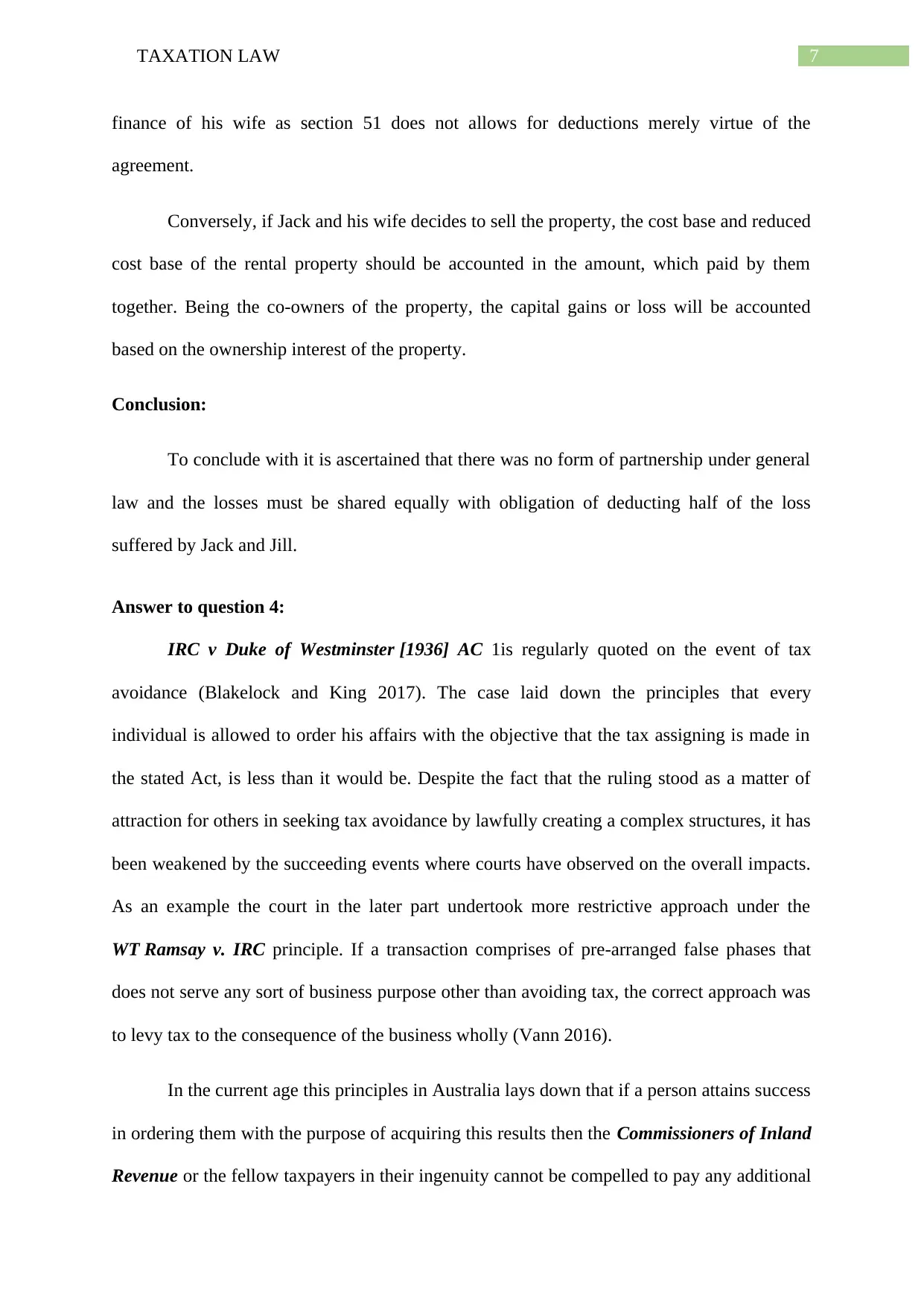
7TAXATION LAW
finance of his wife as section 51 does not allows for deductions merely virtue of the
agreement.
Conversely, if Jack and his wife decides to sell the property, the cost base and reduced
cost base of the rental property should be accounted in the amount, which paid by them
together. Being the co-owners of the property, the capital gains or loss will be accounted
based on the ownership interest of the property.
Conclusion:
To conclude with it is ascertained that there was no form of partnership under general
law and the losses must be shared equally with obligation of deducting half of the loss
suffered by Jack and Jill.
Answer to question 4:
IRC v Duke of Westminster [1936] AC 1is regularly quoted on the event of tax
avoidance (Blakelock and King 2017). The case laid down the principles that every
individual is allowed to order his affairs with the objective that the tax assigning is made in
the stated Act, is less than it would be. Despite the fact that the ruling stood as a matter of
attraction for others in seeking tax avoidance by lawfully creating a complex structures, it has
been weakened by the succeeding events where courts have observed on the overall impacts.
As an example the court in the later part undertook more restrictive approach under the
WT Ramsay v. IRC principle. If a transaction comprises of pre-arranged false phases that
does not serve any sort of business purpose other than avoiding tax, the correct approach was
to levy tax to the consequence of the business wholly (Vann 2016).
In the current age this principles in Australia lays down that if a person attains success
in ordering them with the purpose of acquiring this results then the Commissioners of Inland
Revenue or the fellow taxpayers in their ingenuity cannot be compelled to pay any additional
finance of his wife as section 51 does not allows for deductions merely virtue of the
agreement.
Conversely, if Jack and his wife decides to sell the property, the cost base and reduced
cost base of the rental property should be accounted in the amount, which paid by them
together. Being the co-owners of the property, the capital gains or loss will be accounted
based on the ownership interest of the property.
Conclusion:
To conclude with it is ascertained that there was no form of partnership under general
law and the losses must be shared equally with obligation of deducting half of the loss
suffered by Jack and Jill.
Answer to question 4:
IRC v Duke of Westminster [1936] AC 1is regularly quoted on the event of tax
avoidance (Blakelock and King 2017). The case laid down the principles that every
individual is allowed to order his affairs with the objective that the tax assigning is made in
the stated Act, is less than it would be. Despite the fact that the ruling stood as a matter of
attraction for others in seeking tax avoidance by lawfully creating a complex structures, it has
been weakened by the succeeding events where courts have observed on the overall impacts.
As an example the court in the later part undertook more restrictive approach under the
WT Ramsay v. IRC principle. If a transaction comprises of pre-arranged false phases that
does not serve any sort of business purpose other than avoiding tax, the correct approach was
to levy tax to the consequence of the business wholly (Vann 2016).
In the current age this principles in Australia lays down that if a person attains success
in ordering them with the purpose of acquiring this results then the Commissioners of Inland
Revenue or the fellow taxpayers in their ingenuity cannot be compelled to pay any additional
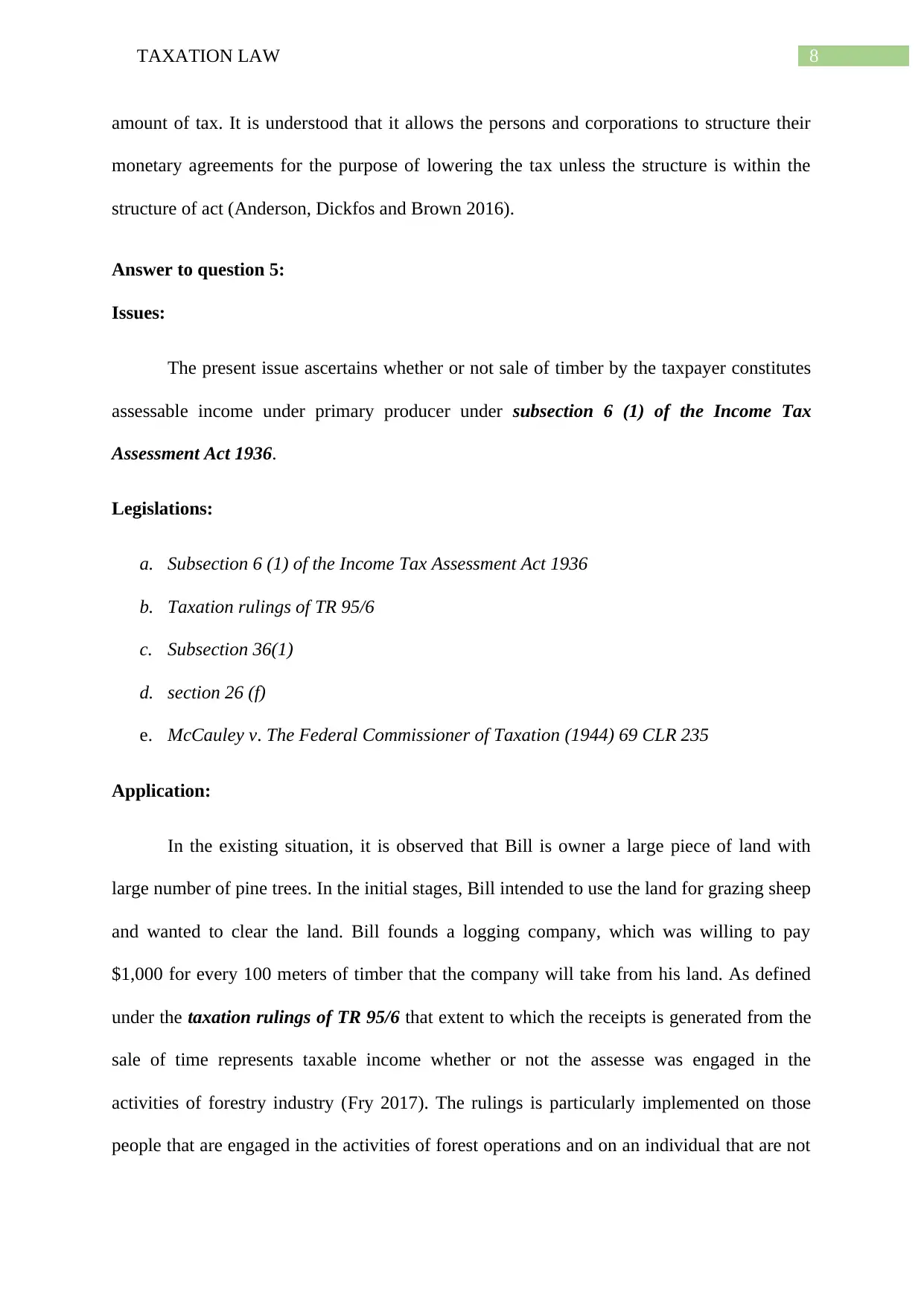
8TAXATION LAW
amount of tax. It is understood that it allows the persons and corporations to structure their
monetary agreements for the purpose of lowering the tax unless the structure is within the
structure of act (Anderson, Dickfos and Brown 2016).
Answer to question 5:
Issues:
The present issue ascertains whether or not sale of timber by the taxpayer constitutes
assessable income under primary producer under subsection 6 (1) of the Income Tax
Assessment Act 1936.
Legislations:
a. Subsection 6 (1) of the Income Tax Assessment Act 1936
b. Taxation rulings of TR 95/6
c. Subsection 36(1)
d. section 26 (f)
e. McCauley v. The Federal Commissioner of Taxation (1944) 69 CLR 235
Application:
In the existing situation, it is observed that Bill is owner a large piece of land with
large number of pine trees. In the initial stages, Bill intended to use the land for grazing sheep
and wanted to clear the land. Bill founds a logging company, which was willing to pay
$1,000 for every 100 meters of timber that the company will take from his land. As defined
under the taxation rulings of TR 95/6 that extent to which the receipts is generated from the
sale of time represents taxable income whether or not the assesse was engaged in the
activities of forestry industry (Fry 2017). The rulings is particularly implemented on those
people that are engaged in the activities of forest operations and on an individual that are not
amount of tax. It is understood that it allows the persons and corporations to structure their
monetary agreements for the purpose of lowering the tax unless the structure is within the
structure of act (Anderson, Dickfos and Brown 2016).
Answer to question 5:
Issues:
The present issue ascertains whether or not sale of timber by the taxpayer constitutes
assessable income under primary producer under subsection 6 (1) of the Income Tax
Assessment Act 1936.
Legislations:
a. Subsection 6 (1) of the Income Tax Assessment Act 1936
b. Taxation rulings of TR 95/6
c. Subsection 36(1)
d. section 26 (f)
e. McCauley v. The Federal Commissioner of Taxation (1944) 69 CLR 235
Application:
In the existing situation, it is observed that Bill is owner a large piece of land with
large number of pine trees. In the initial stages, Bill intended to use the land for grazing sheep
and wanted to clear the land. Bill founds a logging company, which was willing to pay
$1,000 for every 100 meters of timber that the company will take from his land. As defined
under the taxation rulings of TR 95/6 that extent to which the receipts is generated from the
sale of time represents taxable income whether or not the assesse was engaged in the
activities of forestry industry (Fry 2017). The rulings is particularly implemented on those
people that are engaged in the activities of forest operations and on an individual that are not
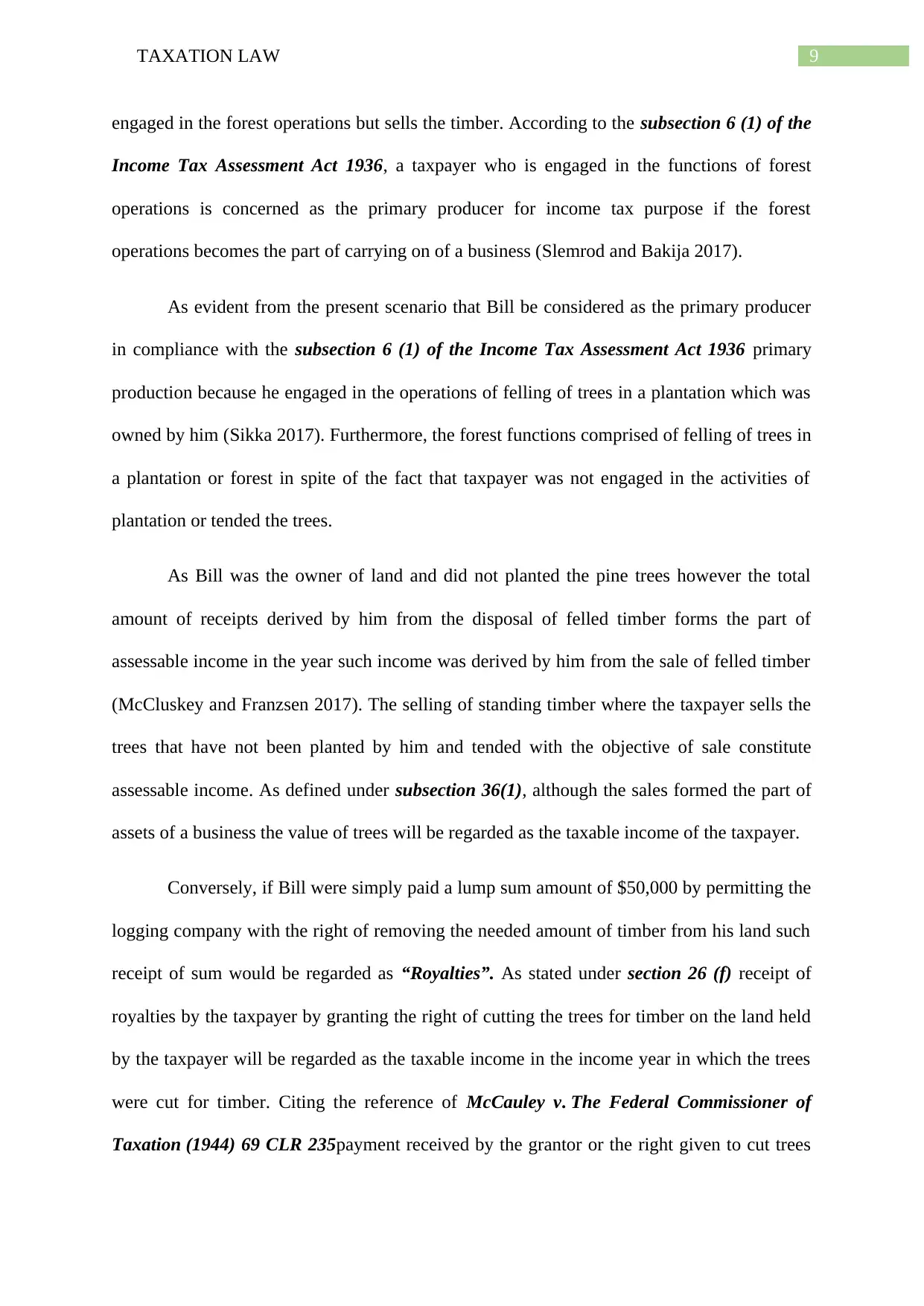
9TAXATION LAW
engaged in the forest operations but sells the timber. According to the subsection 6 (1) of the
Income Tax Assessment Act 1936, a taxpayer who is engaged in the functions of forest
operations is concerned as the primary producer for income tax purpose if the forest
operations becomes the part of carrying on of a business (Slemrod and Bakija 2017).
As evident from the present scenario that Bill be considered as the primary producer
in compliance with the subsection 6 (1) of the Income Tax Assessment Act 1936 primary
production because he engaged in the operations of felling of trees in a plantation which was
owned by him (Sikka 2017). Furthermore, the forest functions comprised of felling of trees in
a plantation or forest in spite of the fact that taxpayer was not engaged in the activities of
plantation or tended the trees.
As Bill was the owner of land and did not planted the pine trees however the total
amount of receipts derived by him from the disposal of felled timber forms the part of
assessable income in the year such income was derived by him from the sale of felled timber
(McCluskey and Franzsen 2017). The selling of standing timber where the taxpayer sells the
trees that have not been planted by him and tended with the objective of sale constitute
assessable income. As defined under subsection 36(1), although the sales formed the part of
assets of a business the value of trees will be regarded as the taxable income of the taxpayer.
Conversely, if Bill were simply paid a lump sum amount of $50,000 by permitting the
logging company with the right of removing the needed amount of timber from his land such
receipt of sum would be regarded as “Royalties”. As stated under section 26 (f) receipt of
royalties by the taxpayer by granting the right of cutting the trees for timber on the land held
by the taxpayer will be regarded as the taxable income in the income year in which the trees
were cut for timber. Citing the reference of McCauley v. The Federal Commissioner of
Taxation (1944) 69 CLR 235payment received by the grantor or the right given to cut trees
engaged in the forest operations but sells the timber. According to the subsection 6 (1) of the
Income Tax Assessment Act 1936, a taxpayer who is engaged in the functions of forest
operations is concerned as the primary producer for income tax purpose if the forest
operations becomes the part of carrying on of a business (Slemrod and Bakija 2017).
As evident from the present scenario that Bill be considered as the primary producer
in compliance with the subsection 6 (1) of the Income Tax Assessment Act 1936 primary
production because he engaged in the operations of felling of trees in a plantation which was
owned by him (Sikka 2017). Furthermore, the forest functions comprised of felling of trees in
a plantation or forest in spite of the fact that taxpayer was not engaged in the activities of
plantation or tended the trees.
As Bill was the owner of land and did not planted the pine trees however the total
amount of receipts derived by him from the disposal of felled timber forms the part of
assessable income in the year such income was derived by him from the sale of felled timber
(McCluskey and Franzsen 2017). The selling of standing timber where the taxpayer sells the
trees that have not been planted by him and tended with the objective of sale constitute
assessable income. As defined under subsection 36(1), although the sales formed the part of
assets of a business the value of trees will be regarded as the taxable income of the taxpayer.
Conversely, if Bill were simply paid a lump sum amount of $50,000 by permitting the
logging company with the right of removing the needed amount of timber from his land such
receipt of sum would be regarded as “Royalties”. As stated under section 26 (f) receipt of
royalties by the taxpayer by granting the right of cutting the trees for timber on the land held
by the taxpayer will be regarded as the taxable income in the income year in which the trees
were cut for timber. Citing the reference of McCauley v. The Federal Commissioner of
Taxation (1944) 69 CLR 235payment received by the grantor or the right given to cut trees
Secure Best Marks with AI Grader
Need help grading? Try our AI Grader for instant feedback on your assignments.
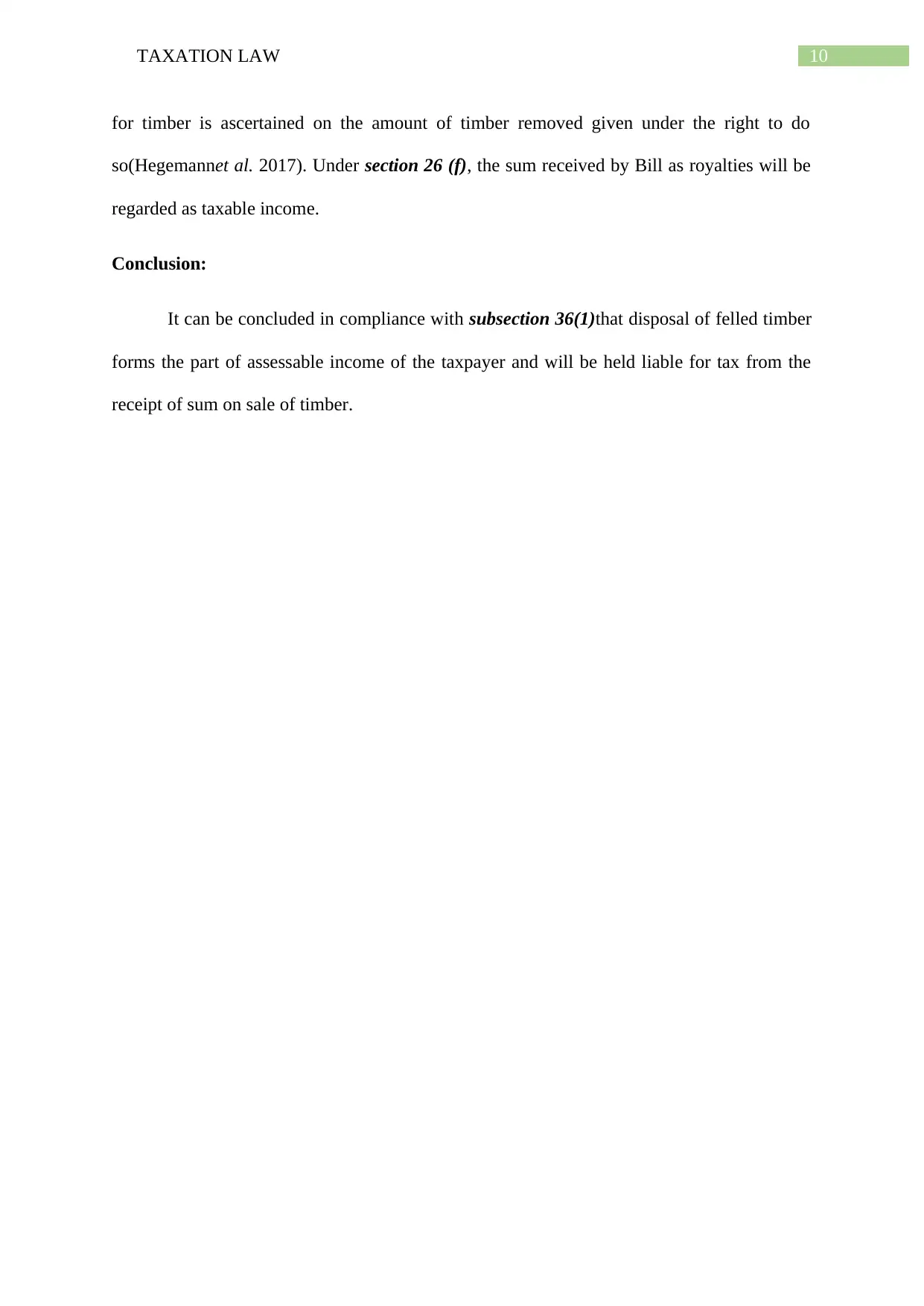
10TAXATION LAW
for timber is ascertained on the amount of timber removed given under the right to do
so(Hegemannet al. 2017). Under section 26 (f), the sum received by Bill as royalties will be
regarded as taxable income.
Conclusion:
It can be concluded in compliance with subsection 36(1)that disposal of felled timber
forms the part of assessable income of the taxpayer and will be held liable for tax from the
receipt of sum on sale of timber.
for timber is ascertained on the amount of timber removed given under the right to do
so(Hegemannet al. 2017). Under section 26 (f), the sum received by Bill as royalties will be
regarded as taxable income.
Conclusion:
It can be concluded in compliance with subsection 36(1)that disposal of felled timber
forms the part of assessable income of the taxpayer and will be held liable for tax from the
receipt of sum on sale of timber.
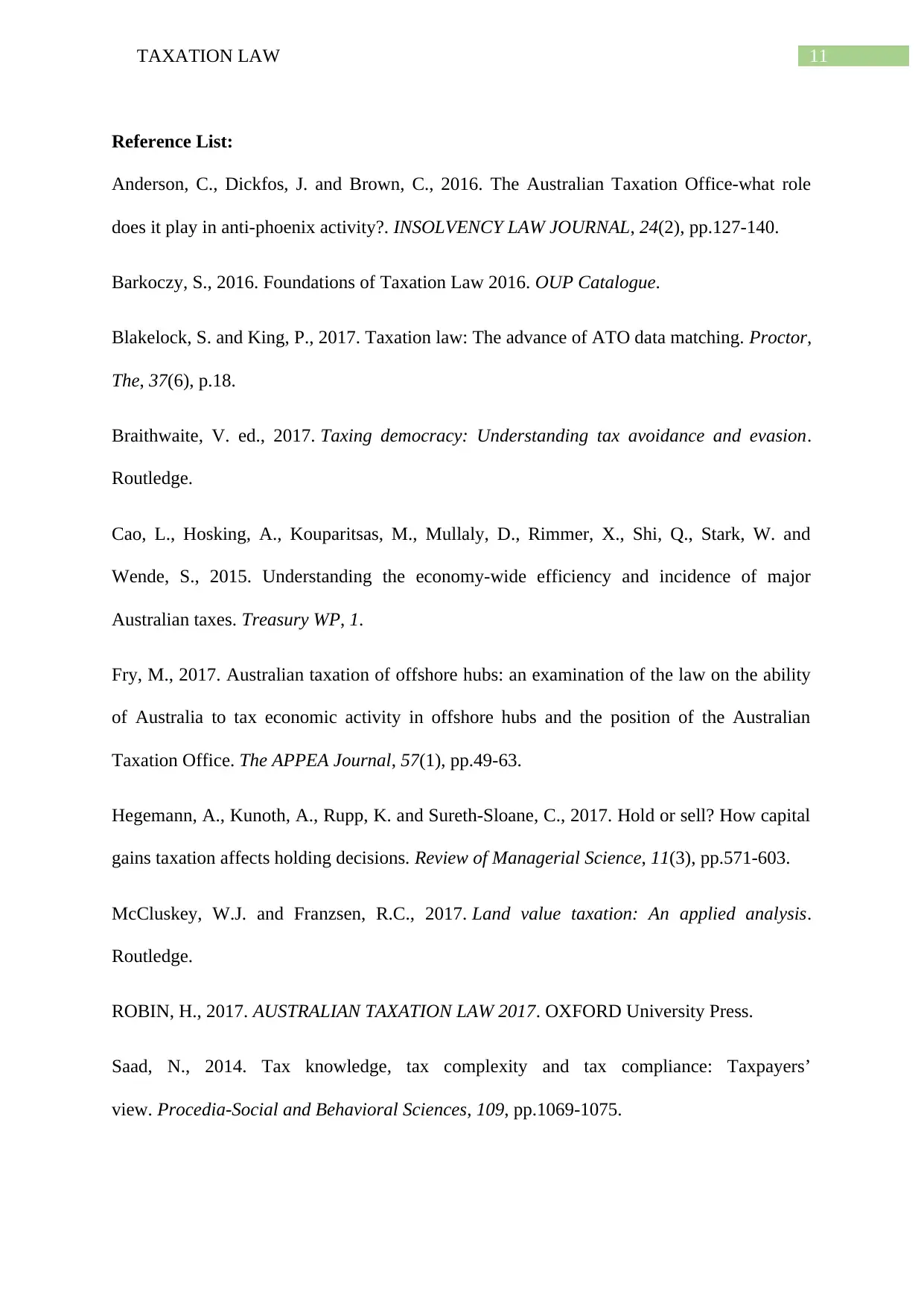
11TAXATION LAW
Reference List:
Anderson, C., Dickfos, J. and Brown, C., 2016. The Australian Taxation Office-what role
does it play in anti-phoenix activity?. INSOLVENCY LAW JOURNAL, 24(2), pp.127-140.
Barkoczy, S., 2016. Foundations of Taxation Law 2016. OUP Catalogue.
Blakelock, S. and King, P., 2017. Taxation law: The advance of ATO data matching. Proctor,
The, 37(6), p.18.
Braithwaite, V. ed., 2017. Taxing democracy: Understanding tax avoidance and evasion.
Routledge.
Cao, L., Hosking, A., Kouparitsas, M., Mullaly, D., Rimmer, X., Shi, Q., Stark, W. and
Wende, S., 2015. Understanding the economy-wide efficiency and incidence of major
Australian taxes. Treasury WP, 1.
Fry, M., 2017. Australian taxation of offshore hubs: an examination of the law on the ability
of Australia to tax economic activity in offshore hubs and the position of the Australian
Taxation Office. The APPEA Journal, 57(1), pp.49-63.
Hegemann, A., Kunoth, A., Rupp, K. and Sureth-Sloane, C., 2017. Hold or sell? How capital
gains taxation affects holding decisions. Review of Managerial Science, 11(3), pp.571-603.
McCluskey, W.J. and Franzsen, R.C., 2017. Land value taxation: An applied analysis.
Routledge.
ROBIN, H., 2017. AUSTRALIAN TAXATION LAW 2017. OXFORD University Press.
Saad, N., 2014. Tax knowledge, tax complexity and tax compliance: Taxpayers’
view. Procedia-Social and Behavioral Sciences, 109, pp.1069-1075.
Reference List:
Anderson, C., Dickfos, J. and Brown, C., 2016. The Australian Taxation Office-what role
does it play in anti-phoenix activity?. INSOLVENCY LAW JOURNAL, 24(2), pp.127-140.
Barkoczy, S., 2016. Foundations of Taxation Law 2016. OUP Catalogue.
Blakelock, S. and King, P., 2017. Taxation law: The advance of ATO data matching. Proctor,
The, 37(6), p.18.
Braithwaite, V. ed., 2017. Taxing democracy: Understanding tax avoidance and evasion.
Routledge.
Cao, L., Hosking, A., Kouparitsas, M., Mullaly, D., Rimmer, X., Shi, Q., Stark, W. and
Wende, S., 2015. Understanding the economy-wide efficiency and incidence of major
Australian taxes. Treasury WP, 1.
Fry, M., 2017. Australian taxation of offshore hubs: an examination of the law on the ability
of Australia to tax economic activity in offshore hubs and the position of the Australian
Taxation Office. The APPEA Journal, 57(1), pp.49-63.
Hegemann, A., Kunoth, A., Rupp, K. and Sureth-Sloane, C., 2017. Hold or sell? How capital
gains taxation affects holding decisions. Review of Managerial Science, 11(3), pp.571-603.
McCluskey, W.J. and Franzsen, R.C., 2017. Land value taxation: An applied analysis.
Routledge.
ROBIN, H., 2017. AUSTRALIAN TAXATION LAW 2017. OXFORD University Press.
Saad, N., 2014. Tax knowledge, tax complexity and tax compliance: Taxpayers’
view. Procedia-Social and Behavioral Sciences, 109, pp.1069-1075.
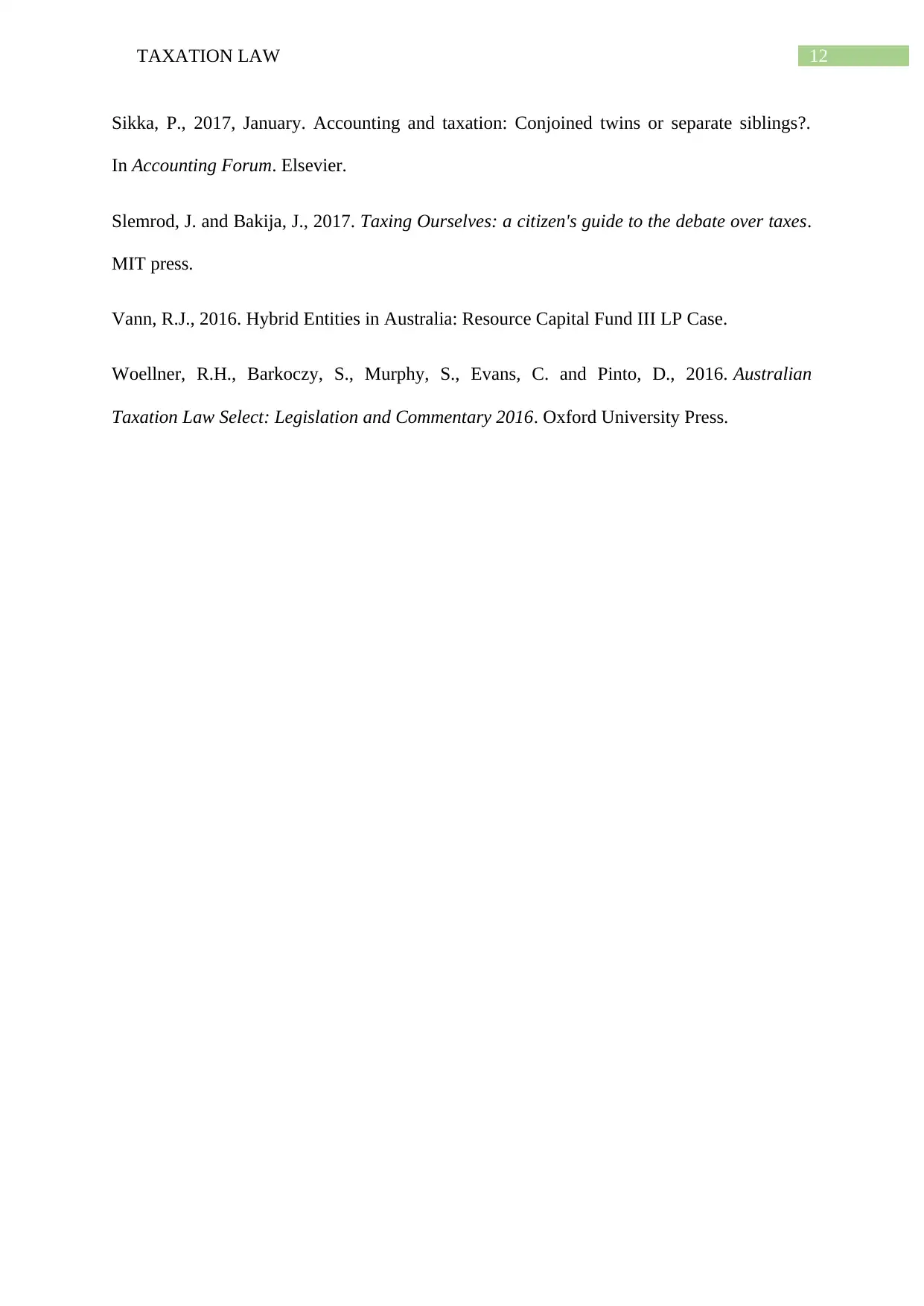
12TAXATION LAW
Sikka, P., 2017, January. Accounting and taxation: Conjoined twins or separate siblings?.
In Accounting Forum. Elsevier.
Slemrod, J. and Bakija, J., 2017. Taxing Ourselves: a citizen's guide to the debate over taxes.
MIT press.
Vann, R.J., 2016. Hybrid Entities in Australia: Resource Capital Fund III LP Case.
Woellner, R.H., Barkoczy, S., Murphy, S., Evans, C. and Pinto, D., 2016. Australian
Taxation Law Select: Legislation and Commentary 2016. Oxford University Press.
Sikka, P., 2017, January. Accounting and taxation: Conjoined twins or separate siblings?.
In Accounting Forum. Elsevier.
Slemrod, J. and Bakija, J., 2017. Taxing Ourselves: a citizen's guide to the debate over taxes.
MIT press.
Vann, R.J., 2016. Hybrid Entities in Australia: Resource Capital Fund III LP Case.
Woellner, R.H., Barkoczy, S., Murphy, S., Evans, C. and Pinto, D., 2016. Australian
Taxation Law Select: Legislation and Commentary 2016. Oxford University Press.
Paraphrase This Document
Need a fresh take? Get an instant paraphrase of this document with our AI Paraphraser

13TAXATION LAW
1 out of 14
Related Documents
Your All-in-One AI-Powered Toolkit for Academic Success.
+13062052269
info@desklib.com
Available 24*7 on WhatsApp / Email
![[object Object]](/_next/static/media/star-bottom.7253800d.svg)
Unlock your academic potential
© 2024 | Zucol Services PVT LTD | All rights reserved.





